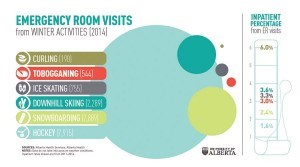
The director for the University of Alberta’s injury prevention centre has questioned the evidence behind the town’s recent tobogganing closures.
According to Don Voaklander, who is also a professor of public health, there are far fewer emergency room visits for tobogganing than skating, snowboarding, skiing or hockey.
Data from Alberta Health Services shows that there were 544 ER visits across the province for tobogganing injuries in 2014 compared to 7,915 ER visits for hockey.
“In my experience looking at surveillance data I wouldn’t consider tobogganing a high-risk activity,” said Voaklander.
Backing up his comments he pointed to the number of ER visits for tobogganing related injuries that required a patient to stay overnight.
Of the 544 ER visits for tobogganing injuries, only three per cent or approximately 16 patients had to stay over night.
In comparison, there were 190 ER visits across the province for curling in 2014, but six per cent or about 11 people required inpatient care. Hockey injuries were the least likely to require overnight care, with approximately 127 patients or 1.6 per cent of ER vists requiring overnight care.
Voaklander said he wasn’t surprise to hear that Jasper had closed two popular tobogganing areas in late January. A third area at Centennial Park remains open for use.
“I know municipalities are under tremendous pressure to keep costs down regarding possible litigation and their insurance costs,” said Voaklander.
He said similar closures have taken place in Calgary where there are now 18 designated spots. Those that are caught sliding elsewhere in the city could face a $100 fine.
In Hamilton the city completely banned tobogganing in 2015 after a local lawyer was injured while tobogganing and successfully sued the city for $900,000. In 2016 the city rescinded its ban after pressure from residents. The city ultimately designated four hills for tobogganing.
“A risk management guy is going to give you the worst-case scenario all the time because he’s telling you how to manage your risks,” said Voaklander.
Doug Wysman, the risk management consultant who advised the town to close Snape’s hill and the church hill, pushed back.
“No one appreciates the value of recreational activities more than I. I have spent many years championing the cause for things like skate parks, bike parks, trails, playgrounds and yes... toboggan hills,” he wrote in an email.
“I’m comfortable with our recommendation to the Town of Jasper that these hills be closed pending an attempt to address safety concerns. I believe the public would have been a lot more upset if I ignored my experience and said ‘what the heck let’s see what happens.’”
Voaklander said the town should have looked at the evidence before making such a quick decision.
“If people have been tobogganing on these hills for years the first thing I would do is look at some local data from the emergency department people go to and see what’s happening there to see if there’s a problem.”
He said he would also look at how people are using the hill, how people are getting injured and also dig up any police reports to see how serious the problem actually is.
“They should look at all aspects of it.”
After reviewing the data himself, Wyseman said he wasn’t surprised that hockey, skating, skiing and snowboarding all have higher frequencies of injuries.
“Using data from the local hospital would show info from those hills, but we all know nothing substantial has happened (in Jasper) yet. The statistics from Alberta as a whole clearly demonstrate the cause for concern and were used to try to let local people know that such accidents do regularly occur across the province,” wrote Wyseman.
He said he also didn’t understand Voaklander’s argument that municipalities are restricting tobogganing to keep insurance and litigation costs down.
“No municipality wants to be found at fault for an injury to a member of the public and no taxpayer wants their tax dollars to have to pay for the town’s failure to act in a reasonably prudent fashion.”
Like many in the community, Voaklander suggested there are several possible ways to mitigate the risks such as removing signs and using bales of hay to stop people from straying onto the roadway.
“Kids have such few spontaneous recreational opportunities these days, so to take something that we all grew up with away without some careful thought put into it I think is a tragedy.”
CAO Mark Fercho said seven residents have stepped forward to create a working group to find ways to mitigate the risks.
To help guide the group, a risk manager for the town’s insurance company (Genesis) and the town’s risk management consultant have offered to lend their knowledge to review the ideas. Voaklander has also assigned one of his senior staff to help.
Paul Clarke
[email protected]
